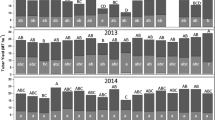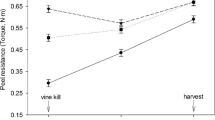Abstract
Russet Burbank, Red Pontiac, and Superior potato plants were treated with vine desiccants at the rate of 0.50 kg/ha and 1.12 kg/ha paraquat + X77, diquat + X77 and 2.24 kg/ha of Dow General, alone and with Crop Oil, 2 to 4 weeks before harvest. Untreated and treated tubers were selected for anatomical examination directly after harvest and after 22 weeks of storage. The tubers were cut in half longitudinally and exposed to optimum environmental conditions for 25 days when they were examined for periderm formation. Wound periderm in untreated tubers consisted of uniformly shaped and continuous layers of cambial cells. Tubers treated with 0.56 kg/ ha paraquat had a less developed periderm than untreated ones, but it would serve as a barrier against the invasion of pathogens. Diquat at the same concentration had fewer cambial cells and they were not continuous so that pathogen entrance was possible. With 1.12 kg/ha paraquat the periderm was less and with diquat more differentiated than the 0.56 kg/ha treatment indicating that concentration had some effect. Treatment with Dow General resulted in the formation of a periderm adequate for prevention of pathogen entrance. The effectiveness of the 3 chemicals to form periderm in Superior and Red Pontiac was similar to that of Russet Burbank. Periderm was most highly differentiated in untreated tubers followed by paraquat, Dow General, and diquat treated tubers.
Resumen
Dos a cuatro semanas antes de la cosecha, se trataton plantas de papa de Russet Burbank, Red Pontiac y Superior con desecantes de follaje, paraquat + X77 y diquat + X77, en dosis de 0,50 kg/ha y 1,12 kg/ha y 2,24 kg/ha de Dow General con Crop Oil o solo. Se seleccionaron tubérculos para examinarlos anátomicamente inmediatamente después de la cosecha y a la 22 semanas de almacenaje. Los tubérculos fueron cortados longitudinalmente por la mitad y expuestos a condiciones ambientales óptimas durante 25 días para, entonces, examinarlos en cuanto a formación de peridermo. En los cortes de los tubérculos sin tratar el peridermo consistía en capas continuas y uniformes de células delcambium. El peridermo estaba menos desarrollado en los tubérculos sin tratar, pero como barrera para una invasión de patógenos era suficiente. Diquat, en una concentración igual, produjo menos cantidad de células delcambium, las cuales quedaron sin continuidad haciendo asi posible la entrada de patógenos. Con la dosis de 1,12 kg/ha, el peridermo resultó diferenciado al usar paraquat y más diferenciado al emplear diquat en comparación con el tratamiento de 0,56 kg/ha, de los mismos productos, lo cual indica que la concentración tiene algún efecto. El tratamiento con Dow General tuvo como resultado la formación de un peridermo adecuado para prevenir la entrada de patógenos. La eficacia de los tres productos químicos para formar peridermo en las variedades Superior y Red Pontiac fue similar en el caso de Russet Burbank. El peridermo estaba más diferenciado cuando no había tratamiento y después, en orden descendente, en tubérculos tratados con paraquat, Dow General y diquat.
Similar content being viewed by others
Literature Cited
Ahrens, J.F. 1975. Vine killers on Katahdin potatoes in Connecticut. Proc Northeast Weed Sci Soc 29:276–280.
Audia, W.V., W.L. Smith, Jr., and C.C. Craft. 1962. Effects of isopropyl N-(3-chlorophenyl) carbamate on suberin, periderm, and decay development by Katahdin potato slices. Bot Gaz 123:255–258.
Cunningham, H.S. 1953. A histological study of the influence of sprout inhibitors on Fusarium infection of potato tubers. Phytopathology 43:95–98.
Dainello, Frank J. and James F. Fontenot. 1971. Chemical induction of suberization in cut potato seed pieces. J Am Soc Hortic Sci 96(2): 194–196.
Johansen, D.A. 1940. Plant microtechnique. McGraw-Hill Book Co., Inc., New York.
Murphy, Hugh J. 1968. Potato vine killing. Am Potato J 45:472–478.
Murphy, Hugh J. and Michael J. Goven. Potato vine killing in Maine — 1972. Proc Northeast Weed Sci Soc 29:269–275.
Sewell, W.D. 1966. Paraquat for potato vine killing. Proc of Northeast Weed Control Conf 20:152–156.
Sieczka, Joseph B. 1972. The effect of potato vine killing with paraquat on storability of potato tubers. Proc Northeast Weed Sci Soc 26:332–337.
Simonds, Austin A., Gestur Johnson and L.A. Schaal. 1953. Comparative effects of catechol, some related compounds and other chemicals on suberization of cut potato tubers. Bot Gaz 115:190–195.
Sparks, Walter C. 1958. A review of abnormalities in the potato due to water uptake and translocation. Am Potato J 35:430–436.
Weiss, F. J., I. Lauritzen and P. Brierly. 1928. Factors in the inception and development of Fusarium rot in storage potatoes. U.S.D.A. Tech Bul 62:35 pp.
Author information
Authors and Affiliations
Rights and permissions
About this article
Cite this article
Struckmeyer, B.E., Binning, L.K. The effect of some vine desiccants on periderm development on cut potato tuber pieces. American Potato Journal 60, 41–46 (1983). https://doi.org/10.1007/BF02853546
Received:
Issue Date:
DOI: https://doi.org/10.1007/BF02853546




